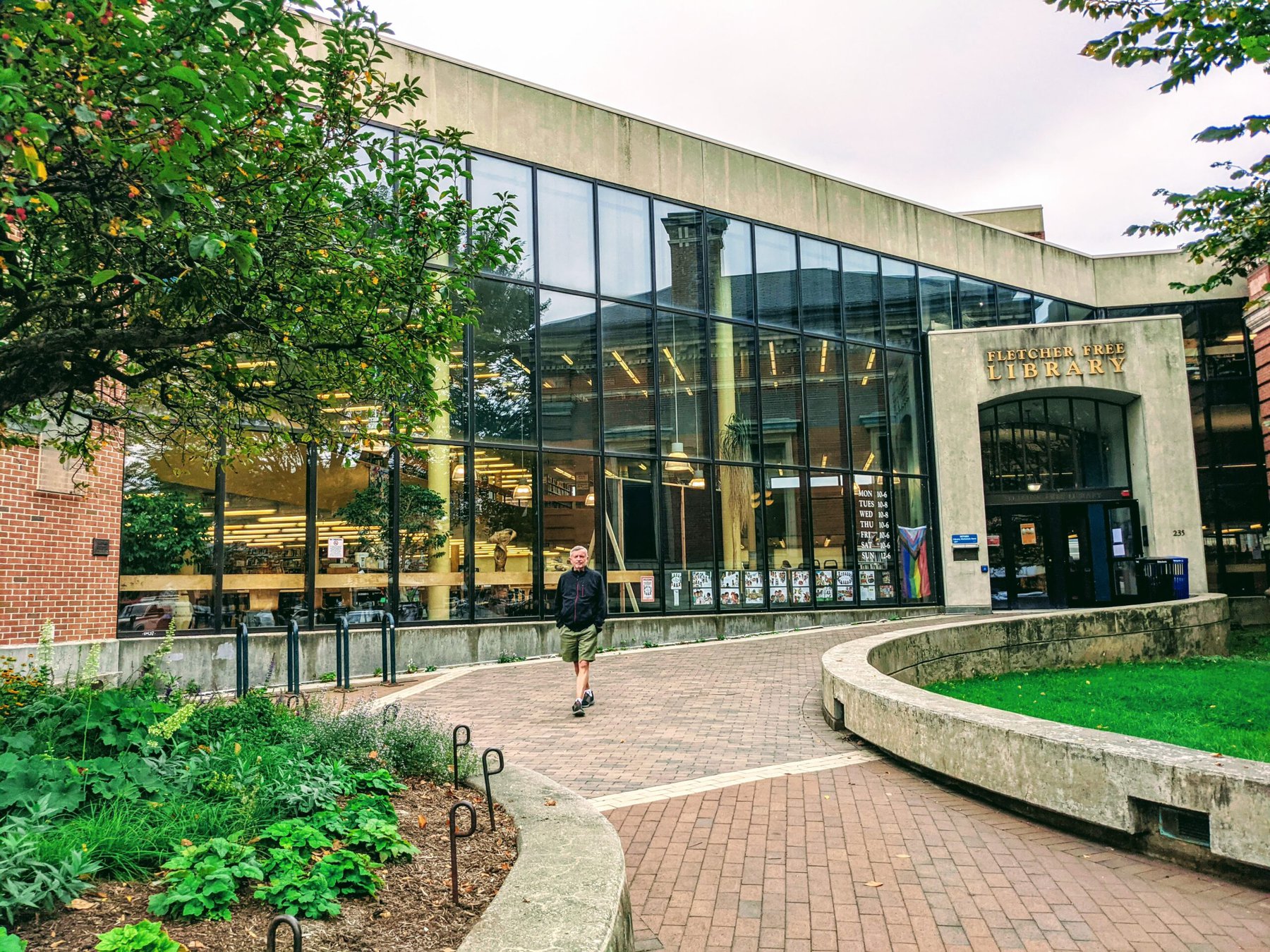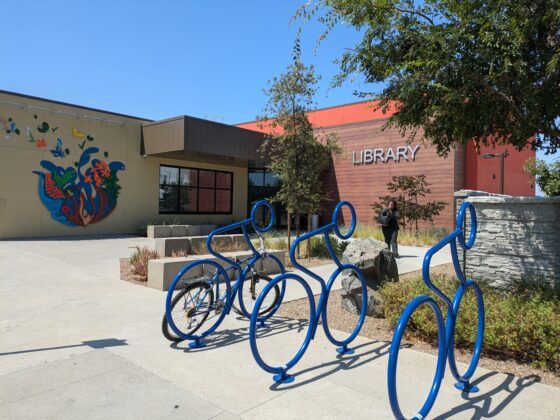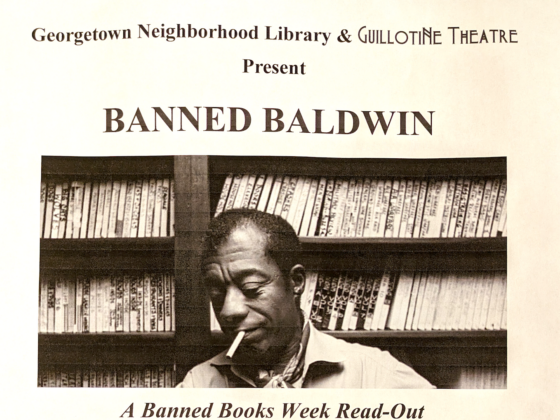Returning to the Fletcher Free Library in Burlington, Vermont, last month closed a loop for me. My husband, Jim, and I first visited Burlington in the fall of 2013, early in our Our Towns adventure. It was the third city in our marathon 5-year, 50-town, 100,000-mile journey, which led to Our Towns, the book, then Our Towns, the HBO documentary, and now the Our Towns Civic Foundation.
Back in 2013, we were feeling our way through reporting on small towns. In Burlington, we wrote about flying, local music, refugees, energy companies, language, start-ups, neighborhood schools, colleges, the local newspaper, and beer! Also during that visit, I stumbled upon the public library. I had just emerged from the old YMCA swimming pool and walked out of the building, my hair still dripping. In front of me across the street was the Fletcher Free Library, with its broad entry and ground-to-roof glass windows.
The reporter side of me (I consider it my yang half of my yin-yang) said: “The library! You should go in and have a look around.” The reluctant side of me (my yin half) said: “Why would I go into the library? What would I be looking for?” The yang: “Whatever you learn will be interesting. Just go in and have a look.” The yin: “What should I ask? They’re busy. I would be wasting their time, fishing around.” The yang: “Just go in.”

So, I did go in, and that changed everything. I began to learn about the new world of the modern public libraries, so different from what I knew from my youth. Today’s libraries are beehives of computer terminals; comfortable reading chairs; calendars of community programs and events; desks and cubbies, friendly librarians; inviting children’s room; shelves of books and games, often a makerspace, and nearly always homeless people keeping warm, or cool. There is an air of busy-ness, activity, and even noise. After Burlington, public libraries became my first stop in every town we visited, my go-to place to learn about the culture of a town from unvarnished, trustworthy sources.
The Fletcher Free Library had been the scene of my first reporting visit, and it then became the scene of my first post-lockdown visit. I was eager to ask how the library staff had weathered the pandemic and what they had learned. I met with the library director, Mary Danko, at nine o’clock sharp on an unusually warm mid-autumn morning. Already, a few homeless people sat quietly on the stone walls around the entry, prepared to wait a good hour until the doors would open.
We sat in the common area, with light streaming in one side and the open upper floors of bookshelves on the other. A series of big display boards were set up near the windows, prepared for Hostile Terrain 94, an exhibit of the Undocumented Migration Project, which is a display of 3400 toe-tags from migrants who had died crossing the Arizona-Mexico border over the last two decades.

Mary Danko and I talked about the covid experience in Burlington, and the library as a central partner in the official response to the crisis. In the early days of the pandemic, Danko was invited with other city department heads to thrice-weekly meetings convened by Mayor Miro Weinberger and the Chief Innovations Officer Brian Lowe, to plan and execute emergency response operations. The group included managers from all over the city: from the local hospital, schools, public works, the library, the city arts department, parks and recreation..everyone. Danko described it as “collective brainpower.” And repeatedly, she reminded me that science and analytics research drove their decisions.
In a city as small as Burlington, and a state as small as Vermont, advantages of size were built-in. Since the members already knew each other, communications could be shorthanded. Messaging was easy to coordinate and to amplify through each others’ newsletters and social media. Different offices called on each other for help.
When 1000 new messages flooded city hall from people asking about the BIPOC (Black, Indigenous, People of Color) Vaccination Clinic, the mayor turned to various departments to respond to each call with the correct information. When covid cases were reported to the state’s health department, they called the library to help with contact tracing. “That was a natural match,” said Danko, as “staff was used to talking and working through tough stuff.”

Indeed, library directors from around the country have described how their customers have often come to the library first with their most personal, sensitive issues, and how staff is trained to answer or help or direct them for counsel. Topics covered many of life’s urgent, practical needs like meeting mortgage payments and rents, or addressing medical concerns, or, poignantly, how to seek help with burial costs. Covid-19 became another.
The library also supported the City’s Resource and Recovery Center (RRC). Library staff helped with other city employees and counseled people on navigating covid-driven unemployment and securing benefits and loans. On a granular level, they delivered groceries to elderly folks who were stranded indoors. They raised spirits of those under quarantine, dropping off goodie bags, with library cards tucked inside.
Inside the library, Danko gave the supervisors lots of leeway from normal routines. They set up tables outside for curbside book delivery, until that stopped abruptly with the close-down orders. “It was one of the saddest days in my career,” said Danko, who went on to describe the library as a place with “so much vibrancy where people were coming in and wandering about. There were those who depended on the library as their daily touchstone, or for their weekly books.“ She didn’t cry on the day of the order to lock up, Danko told me, but a few days later, seeing the signs on the doors and the eeriness of the city, she burst into tears. “It was so closed,” she said.
The staff, cut loose to be creative, began to act virtually. When one thing didn’t work, they pivoted to another. They shifted funds from programming to online efforts. They promoted online resources of the library, emailing some people and talking by phone to others, with instructions one by one on how to find barcodes and pins to get into the online systems. They boosted their outside wifi when the library was closed, and later added outdoor tables and seating, and ran extension cords through the windows so people could charge their devices outdoors. “Try anything, be agile, jump in and do it, and if it doesn’t work, try something else,” Danko described.
The virtual book discussions grew bigger and bigger audiences, attracting those whose lifestyles had made it hard to get out in the evenings, but now showed up online. The youth department put together “mystery bundles”. They curated book collections on themes, like the ever-popular dinosaurs. They assembled “take and make” activity packets for teens and adults. When summer rolled around, college-age interns showed up with free books and activities and t-shirts at pop-up libraries in the parks.
When I asked Danko about lessons learned during covid, she rattled off a list. She described some practical changes that were likely to stick, like hybrid programming. She embraced the agility to try new things, to pivot, and change. She pointed to the softer notions about the power of the library in people’s lives. Danko described one elderly woman, housebound since January, who was ecstatic at returning to the reopened library, saying she had read and reread every book she owned three times during the lockdown. Danko described parents who spoke with gratitude for all the staff had done for their children stuck at home.
Like many others who have reflected during covid on their lives and livelihoods, so have those who work in the libraries. Danko talked in high-level terms about a few of her sentiments on libraries: the power of stories to sweep people away, even if temporarily and especially during troubled times; the importance of the library as a safe place for freedom of speech and ideas, and for civilized conversations about difficult topics; and the value of books as a vehicle for those conversations. I thought Mary Danko had a pretty good list, one worth repeating to remind us all of the value of the library as a democratic institution.




